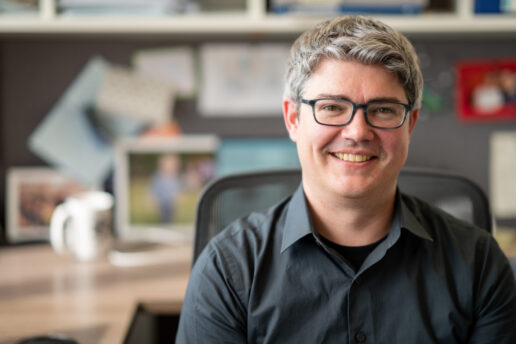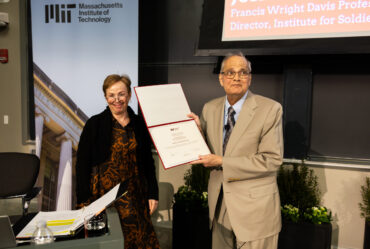
Research pulled Michael McDonald in and it won’t let go
Since his first encounter with a research telescope, the astrophysics professor hasn’t slowed in his quest to understand the behavior of galaxies.
An excellent student in math, science, and computing, Michael McDonald was nonetheless lukewarm about pursuing a career in any of those areas. It wasn’t until he actively engaged in the process of discovery related to astronomy research that he fell in love professionally.
“I think I might have become a programmer in an alternate universe, since that’s where I excelled in university,” says McDonald, associate professor at MIT’s Kavli Institute for Astrophysics and Space Research. “But my first experience of astronomy research was really the first time I thought maybe this is something I could do for the rest of my life.”
In his junior year at Queen’s University in Ontario, Canada, McDonald asked a professor named Stéphane Courteau if he could work with him over the summer. That summer changed everything for McDonald.
“He gave me my first taste of research and brought me to Mauna Kea in Hawaii to use a research-grade telescope for the first time,” he says. “This was a life-altering experience, and I immediately dug into research and haven’t really slowed down since.”
McDonald earned three degrees at Queen’s University: two bachelor’s degrees, one in math and statistics and one in astrophysics, and a master’s degree in astronomy. After earning his PhD in astrophysics at the University of Maryland, he applied for fellowships and was offered the top Canadian and Australian awards as well as a non-fellowship position at MIT with Mark Bautz, senior research scientist and associate director at the MIT Kavli Institute for Astrophysics and Space Research.
Having really wanted the NASA Hubble or Einstein Fellowship, McDonald learned that he had missed the Einstein by just one place — they awarded six that year, and he was ranked seventh. McDonald says he spent a long time “stewing” with his wife over what to do, then declined the Canadian and Australian fellowships and took the position at MIT so he could reapply for the Einstein and NASA Hubble Fellowship the following year.
“I looked up everybody who was ranked ahead of me in the Hubble/Einstein lists, and identified areas where I was weaker,” he says. “I spent that first year at MIT working long hours and tuning out distractions as best I could, and between 2011 and 2012 I published seven papers as first author.”
Offered both the Einstein and Hubble, McDonald accepted the NASA Hubble Fellowship.
Now an associate professor of physics at MIT’s Kavli Institute for Astrophysics and Space Research, McDonald is best known for the discovery of the Phoenix cluster of galaxies. Researchers discovered in the 1980s that galaxy clusters were filled with a hot, diffuse gas, and that this gas ought to eventually cool, fueling the formation of new stars, McDonald says. Throughout the 1990s and 2000s, however, no evidence was found for this cooling, or the resultant star formation, and researchers mostly gave up on the idea of the cooling flows.
In 2012, McDonald and his team discovered a “bonafide cooling flow” in the Phoenix cluster. To this day, “it remains the only such system that we’ve discovered, which makes it a valuable laboratory to study a variety of rare physical phenomena” related to the nature and origins of the universe, he says.
To explain why the hot gas within galaxy clusters is expected to cool, why most clusters don’t show evidence of cooling, and why the Phoenix cluster is different, McDonald was quoted in 2019 using an analogy, an explanatory technique at which he excels.
Comparing a galaxy cluster to a cup of coffee, he told MIT News that, “It’s a 10-million-degree cup of coffee, but even a 10-million-degree cup of coffee is going to cool.” Most galaxy clusters, though, behave more like a cup of coffee on a warming plate. “The warmer is the black hole in the center of the galaxy, and every cluster observed has a warm interior.”
Except for the Phoenix cluster.
The black hole at its center isn’t able to keep the hot gas in the galaxy from fully cooling, McDonald explained, adding that it was as if the 10-million-degree cup of coffee was placed on the counter rather than on a warming plate, letting it cool enough to form new stars.
McDonald’s use of such metaphors, especially for news articles or when speaking to the public, is a skill that he finds extremely useful.
“The vastness and complexity of space is really hard to grasp for all of us, and simplifying metaphors go a long way,” he says. “I do this for myself, too, which helps me to understand new concepts or discoveries.”
Another strategy McDonald uses to understand a concept he finds challenging is to shelve it so that his subconscious can take over. “When I am stuck on something, or don’t fully understand it, I tend to put it aside fairly quickly and move onto something that I can make progress on,” he says. “Usually within 24 hours, whether in bed, or in the shower, or on the train, I’ll have a breakthrough and then I’ll pick the problem back up again.
“In computer nerd speak, I run a lot of jobs in the background.”
The initial discovery of the Phoenix cluster was based on a relatively small, older telescope. As McDonald’s team learned more about it, they utilized more powerful telescopes, including the Magellan telescope in Chile and finally the Hubble Space Telescope. McDonald says that the three images representing those phases of observation — the first published in 2012 and the last in 2019 — demonstrate “how you do science.”
“First we got an image of the Phoenix cluster with a telescope that was easy to get time on,” he says. “When we realized that it was an exciting system, we went to an improved facility, which then motivated going to the best facility.”
“If we had just asked to get Hubble data right away, we would have been laughed out of the room, since we had no compelling reason at that point to waste astronomy’s most valuable resource. Science takes a long time sometimes.”
That process and the discoveries it yields are what continue to motivate McDonald.
“There’s an old book called ‘Cosmic Discovery’ that discussed the idea that every time we look at the sky in a new way, with dramatically improved technology (either in image quality or wavelength of light), we discover entirely new phenomena,” he says. “That’s what I’m most excited for — the new class of objects lurking out there that we don’t even have names for yet.”


